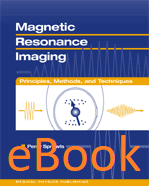
Magnetic Resonance Imaging: Principles, Methods, and Techniques, eBook
Author: Perry SprawlsISBN: 9781951134044
Published: 2000 | 200 pp | eBook
Price: $ 45.00
SCOPE | December 2001
"This book presents an eloquent non-mathematical introduction to the principles of magnetic resonance imaging. The basics of MRI are presented clearly and each chapter ends with a 'mind map summary' which is a composite diagram of the principles explained in the preceding chapter. In general, these mind maps are excellent summaries of the chapter. Overall, the illustrations are of very high quality and complement the text.
"The text starts with a general overview of MR principles followed by chapters on hardware, nuclear magnetic resonance principles and tissue magnetisation and relaxation. Despite some minor compromises with scientific accuracy and consistency, the physical processes are described clearly with excellent diagrams. Contrast formation is covered and k-space is introduced.
"Spin echo and gradient echo techniques are presented in chapters 6 and 7. These cover the topics well. Dr. Sprawls introduces another acronym for gradient echo image (SAGE - small angle gradient echo) which is unnecessary and likely to cause more confusion rather than his intention to simplify matters. Fast gradient echo methods such as GraSE and echo planar imaging (EPI) are introduced. A separate chapter incorporating these and fast spin echo would have been more logical.
"Chapter 8 provides a very clear description of selective signal suppression techniques supported by excellent diagrams. A more detailed description of chemical saturation techniques would also have been desirable. Spatial localisation techniques are presented very simplistically in chapter 9 whilst chapters 10 and 11 provide a clear introduction to image quality issues and procedure optimisation. These latter two chapters provide an excellent practical understanding of what constitutes a good image and the choices the user can make to affect this in terms of contrast sensitivity, resolution and signal to noise ratio. The principles of k-space are also reinforced in these chapters.
"More specialist applications such as vascular imaging, diffusion and perfusion imaging are introduced in chapters 12 and 13. It is surprising that the increasingly prevalent contrast-enhanced magnetic resonance angiography gets only a fleeting mention whilst time of flight and phase contrast methods are dealt with more thoroughly. The only equation in the book is that governing signal attenuation in the presence of diffusion which is unnecessary if we can get by without the Larmor equation. Chapter 14 on artefact reduction covers the basic artefacts including motion, aliasing and chemical shift artefacts. The final chapter is devoted to MR safety.
"This book is well constructed, logically set out and is accompanied by excellent diagrams and the criticisms noted do not detract from the overall text. Its overall aim of appealing to physicians, radiographers and scientific staff is too broad due to its introductory nature and limited scope. However, it would be a valuable addition to an MR unit's library for non-scientific staff who are just embarking on a career in MRI."
--Dan Wilson


